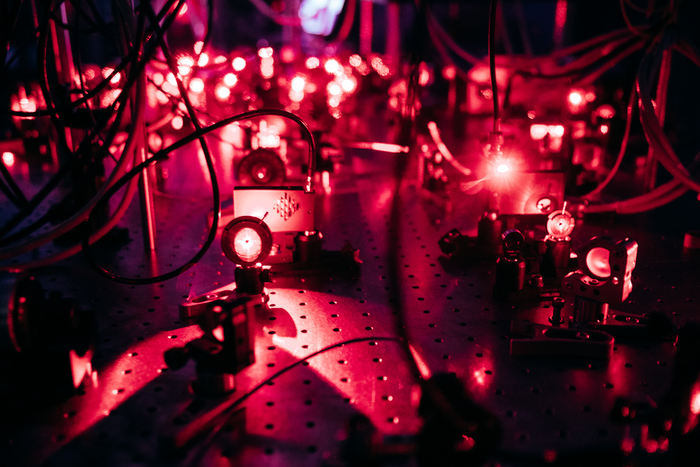According to a paper published in Physical Review Letters, Dartmouth researchers have created the world’s first superfluid circuit using pairs of ultracold electron-like atoms.
 Researchers at Dartmouth have built the world’s first superfluid circuit that uses pairs of ultracold electron-like atoms. Image Credit: Robert Gill/Dartmouth College.
Researchers at Dartmouth have built the world’s first superfluid circuit that uses pairs of ultracold electron-like atoms. Image Credit: Robert Gill/Dartmouth College.
The laboratory testbed allows physicists to alter the strength of atom-to-atom interactions, giving them a new opportunity to investigate the mechanisms behind exotic materials like superconductors.
Much of modern technology revolves around controlling the flow of electrons around circuits. By using electron-like atoms we can test theories in ways that were not possible before.
Kevin Wright, Study Senior Researcher and Assistant Professor, Physics, Dartmouth
While conductive materials like copper are widely understood, scientists are still learning about how electrons travel and can be manipulated in exotic materials like topological insulators and superconductors, which may be used to develop quantum computers.
The novel circuit works as a quantum emulator to investigate how electrons behave in actual materials, allowing researchers to study electron mobility in a highly controlled environment.
Electrons can do things that are far more strange and rich than anyone imagined. We are learning about electrons without using electrons.
Kevin Wright, Study Senior Researcher and Assistant Professor, Physics, Dartmouth
Bosons and fermions are two types of atomic particles. Photons, for example, tend to group together. Fermions, like electrons, have a tendency to avoid each other. While superfluid circuits utilizing ultracold boson-like atoms are already known, the Dartmouth circuit is the first to utilize ultracold atoms that behave as fermions.
The lithium-6 isotope is used in the circuit. Due to the fact that lithium-6 is a complete atom, it possesses properties that allow it to behave like a single electron. Individual electrons can be compared to the behavior of the complete atom.
If we could scale the properties of lithium-6 atoms to electrons, they would be flowing without resistance even above room temperature. Studying these simple circuits might provide insights about high-temperature superconductivity.
Yanping Cai, Study First Author and PhD Candidate, Dartmouth
The minuscule circuit uses laser light to freeze clouds of lithium atoms to temperatures approaching absolute zero. The researchers may then hold the atoms in place, shift them around, or otherwise regulate them in ways that replicate how individual electrons travel along with superconducting circuits once they have been slowed.
The researchers were able to modify the way the atoms interact by adjusting magnetic fields, causing the fermions to attract or repel each other with varied intensity, a characteristic not achievable with individual electrons or other superfluid systems like liquid helium.
According to the researchers, similar techniques have been used in other experiments with lasers, but this is the first atomic circuit that is switchable in this way. The lasers also help to define the circuit’s structure and detect how the atoms are behaving.
“We have crossed the threshold to build test circuits with fermionic quantum gases. Designing and controlling the atom flow around a circuit with ultracold fermions in the same way that is done in an electronic device has never been accomplished before,” added Wright.
Researchers will be able to analyze the formation and decay of “persistent currents,” which flow forever without requiring any energy input.
The ability to simulate superconducting circuits might open up a lot of opportunities for testing ideas and analyzing materials with unusual characteristics in the lab. The findings may pave the way for the creation of novel devices based on superconductors as well as other exotic quantum materials.
Dartmouth Ph.D. candidates Daniel Allman and Parth Sabharwal are co-authors of the study publication. The National Science Foundation provided funding for this research. A CAREER award from the National Science Foundation will fund future research.
Journal Reference:
Cai, Y., et al. (2022) Persistent Currents in Rings of Ultracold Fermionic Atoms. Physical Review Letters. doi.org/10.1103/PhysRevLett.128.150401.